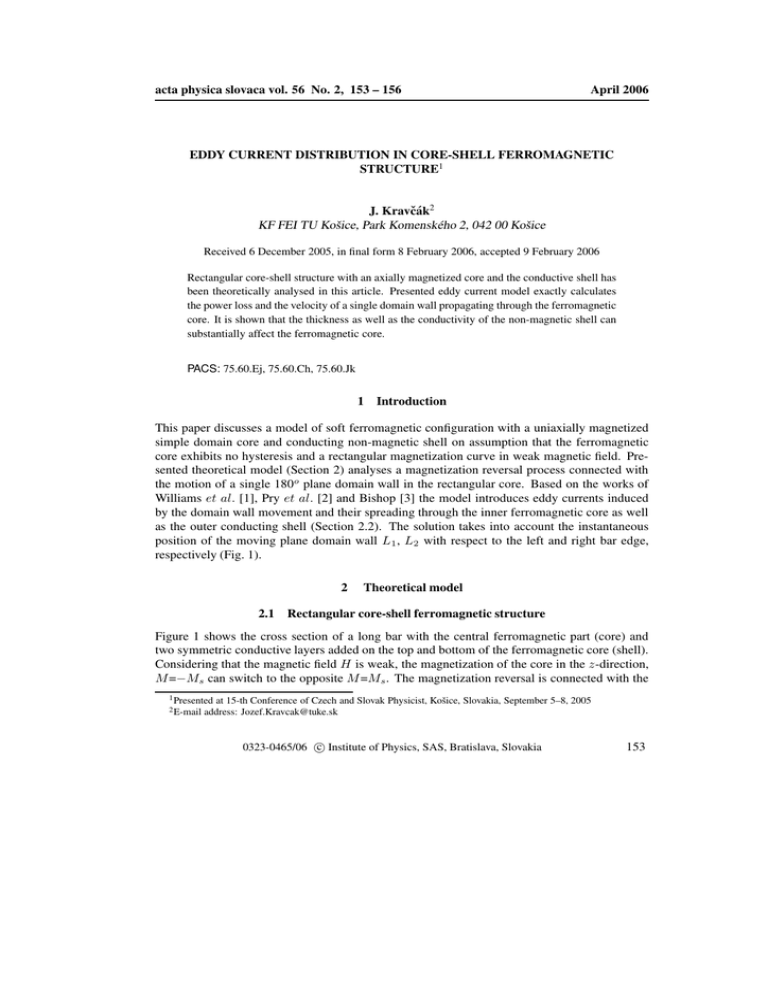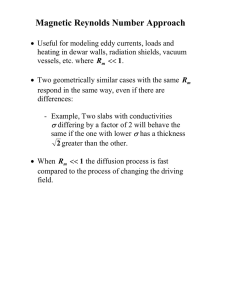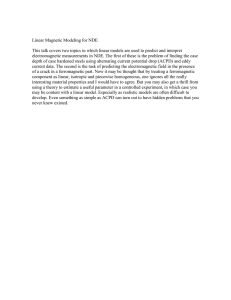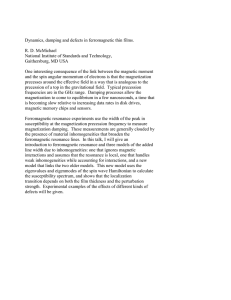KF FEI TU Košice, Park Komenskщho 2, 042 00 Košice
advertisement

acta physica slovaca vol. 56 No. 2, 153 – 156 April 2006 EDDY CURRENT DISTRIBUTION IN CORE-SHELL FERROMAGNETIC STRUCTURE1 J. Kravčák2 KF FEI TU Košice, Park Komenského 2, 042 00 Košice Received 6 December 2005, in final form 8 February 2006, accepted 9 February 2006 Rectangular core-shell structure with an axially magnetized core and the conductive shell has been theoretically analysed in this article. Presented eddy current model exactly calculates the power loss and the velocity of a single domain wall propagating through the ferromagnetic core. It is shown that the thickness as well as the conductivity of the non-magnetic shell can substantially affect the ferromagnetic core. PACS: 75.60.Ej, 75.60.Ch, 75.60.Jk 1 Introduction This paper discusses a model of soft ferromagnetic configuration with a uniaxially magnetized simple domain core and conducting non-magnetic shell on assumption that the ferromagnetic core exhibits no hysteresis and a rectangular magnetization curve in weak magnetic field. Presented theoretical model (Section 2) analyses a magnetization reversal process connected with the motion of a single 180o plane domain wall in the rectangular core. Based on the works of Williams et al. [1], Pry et al. [2] and Bishop [3] the model introduces eddy currents induced by the domain wall movement and their spreading through the inner ferromagnetic core as well as the outer conducting shell (Section 2.2). The solution takes into account the instantaneous position of the moving plane domain wall L1 , L2 with respect to the left and right bar edge, respectively (Fig. 1). 2 Theoretical model 2.1 Rectangular core-shell ferromagnetic structure Figure 1 shows the cross section of a long bar with the central ferromagnetic part (core) and two symmetric conductive layers added on the top and bottom of the ferromagnetic core (shell). Considering that the magnetic field H is weak, the magnetization of the core in the z-direction, M =−Ms can switch to the opposite M =Ms . The magnetization reversal is connected with the 1 Presented 2 E-mail at 15-th Conference of Czech and Slovak Physicist, Košice, Slovakia, September 5–8, 2005 address: Jozef.Kravcak@tuke.sk c Institute of Physics, SAS, Bratislava, Slovakia 0323-0465/06 153 J. Kravčák 154 Fig. 1. Magnetization reversal of ferromagnetic core due to the propagation of the single plane domain wall in the x-direction. propagation of a single 180o plane domain wall in the x-direction (the curvature of the wall is neglected). The origin of a coordinate system is at the center of the wall cross section, i.e., the wall is in the plane x = 0. The width of the ferromagnetic core in the y-direction is d, the overall width of the bar in the x-direction is L1 +L2 and in the y-direction is h. L1 and L2 are the wall distances from the left and the right bar edges, respectively. 2.2 Eddy current calculation If a weak magnetic field H is applied, negligible in comparison with M s , the current density j is the solution of the following equations: dM , dt γ is the electrical conductivity. The boundary conditions are: 1) j n = 0, normal component of j is equal to zero on all outer surfaces, 2) ±jy = γ µ0 Ms v in the wall position, where v is the wall velocity in x-direction. The resulting eddy current density may be verified to be of the form: ∞ h nπ i X nπ h jx (x, y) = − Dn sinh (L2 − x) cos y− , h h 2 n=1 ∞ i h nπ X nπ h (L2 − x) sin Dn cosh jy (x, y) = − y− , x ∈ h0+ , L2 i and h h 2 n=1 (1) ∞ i h nπ X nπ h (L1 + x) cos jx (x, y) = − Dn sinh y− , h h 2 n=1 ∞ i h nπ X nπ h (L1 + x) sin jy (x, y) = + Dn cosh y− , x ∈ h−L1 , 0− i, h h 2 n=1 ∇2 j = 0, curl j = 0, div j = 0, except within the wall, where curl j = −γ µ 0 where 4 γ µ0 Ms v sin nπ sin 2 Dn = nπL1,2 nπ cosh h nπd 2h , for n = 1, 2, 3, . . . . Eddy current distribution in core-shell ferromagnetic structure 1 155 3.5 0.8 0.4 0.2 2y / h ! 3.0 0.6 0 −0.2 2.5 2.0 1.5 " $ # −0.4 1.0 −0.6 −0.8 −1 −1 0.5 −0.8 −0.6 −0.4 x/L −0.2 0 0.2 1 0.4 0.6 x/L 0.8 0 1 0.2 Fig. 2. Eddy current density distribution around the moving domain wall (vertical line) in the cross section of the rectangular bar with core-shell structure. Displayed in reduced x, y coordinates. 2.3 0.4 0.6 0.8 1.0 L 1 / ( L 1+ L 2 ) 2 Fig. 3. Dependence of the domain wall velocity v on its position (distance L1 ) and on the ratio d/h (see Fig. 1) calculated from Eq. 5. Power loss and domain wall velocity When the 180 plane domain wall moves with velocity v (see Fig. 1), the power per unit length in the z-direction P supplied by the magnetic field H is proportional to the rate of magnetization change dM/dt [4] and this gives the following form for P : o (2) P = 2µ0 Ms Hvd. Let us assume that the energy supplied by the magnetic field is completely converted to heat produced by the eddy currents and other types of power loss are negligible. The power loss per unit length in the z-direction P can be calculated from the eddy current density (Section 2.2): Z Z Z Z h/2 1 L2 h/2 2 1 0 2 2 (3) jx + jy2 dxdy, j + jy dxdy + P = γ −L1 −h/2 x γ 0 −h/2 which comes out after carrying out the indicated integration, to be ∞ 8h2 γµ20 Ms2 v 2 X −3 nπL1 nπd nπL2 2 nπ 2 P = tanh n + tanh sin sin . π3 h h 2 2h n=1 (4) Equating Eq. 2 and Eq. 4 gives the following form for the velocity of the domain wall v: v= π3 d P −3 tanh 4h2 γµ0 Ms ∞ n=1 n The series in Eq. 4, 5 contain terms sin2 since they contain the ratio d/h. nπL1 h nπd 2h H + tanh nπL2 h sin2 nπ 2 sin2 nπd 2h . (5) , which depend on the geometrical configuration J. Kravčák 156 3 Discussion This paper presents the analytical solution of the eddy current density j arround the propagating 180o plane domain wall in a rectangular bar with core-shell structure (Fig. 1). It is assumed that the domain wall overcomes the eddy current drag and it remains planar in a weak magnetic field. In order to get a simple expression for the eddy current density j (Eq. 1), the same values of electrical conductivity γ for the shell and core are used. This does not bring any remarkable qualitative change in obtained reasults. The eddy current density j arround the propagating domain wall vs. reduced coordinates is shown in the plot (Fig. 2), which can represent the wall in any position. As can be seen in Fig. 2, the eddy currents spread also through the outer conductive shell. In absence of restoring force and assuming linear dependence of the domain wall velocity v on magnetic field H, the analytical expression for v was derived (Eq. 5). The concave dependence of the domain wall velocity v on the wall position L 1 (Fig. 3) exhibits maximum value v on the bar edge, the minimum value v at the bar centre. The velocity v also decreases with the increasing ratio of the core width d to the overall bar width h. This behaviour gives the possibility to use the model of core-shell structure in many practical applications, where technological adjustment of magnetization reversal process is required. The power loss P , which is directly proportional to v (Eq. 2), significantly decreases with the increasing d/h ratio (Eq. 4). References [1] [2] [3] [4] H. J. Williams, W. Shockley, C. Kittel: Phys. Rev. 80 (1950) 1090 R. H. Pry, C. P. Bean: J. Appl. Phys. 29 (1958) 532 J. E. L. Bishop: J. Magn. Magn. Mat. 49 (1985) 241 S. Chikazumi: Physics of Magnetism, John Wiley and Sons, New York 1964



